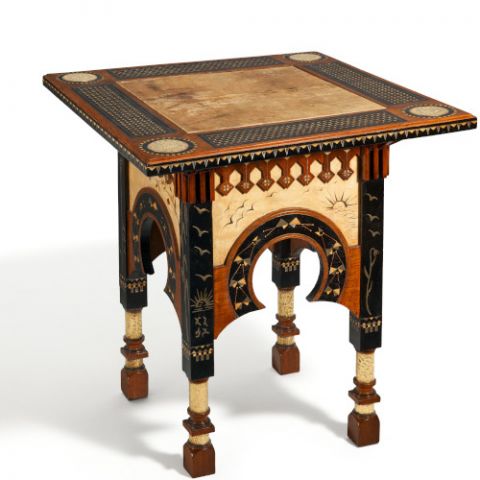
Lot was sold
Lot 38 | Magnificent wooden table clock
Estimate
15.000
- 16.000
€
D
Result:
(incl. premium)
19.800 €
MAGNIFICENT WOODEN TABLE CLOCK.
Liebherr I, Franz Xaver. Immenstadt
Date: Around 1770.
Technique: Coloured and partially gilt wood, clear glass. Brass, blued steel, a.o.
Description: Glassed rectangular case on four sturdy volute feet and with curved pediment. Hinged doors on the front and left side. Inside the clockwork with magnificent cartouche-shaped front plate. The fire gilt plate densely decorated with curved rocaille décor as well as cartouches. Small flowers and seashell ornaments in between. Silver-plated number ring with Latin hours and Arabic minuterie. Solid brass plate movement with key wound and immovable barrels.
3 windings on the back plate, 30-hour movement. Quarter hour strike on 2 bells with a hammer that tilts to the respective bell, strike sequence 1/4 - 2/4 - 3/4 on high bell, 4/4 4 strikes high, then hammer is tilted and strikes the hours on large bell).Striking and count wheel mechanism (Regulator for striking mechanism at 12 o'clock). Carillon with 10 bronze bells and 16 hammers with 4 melodies, selectable via dial at 2 o'clock. Playing time per piece approx. 20-30 seconds depending on spring force.
Carillon operated with chain and fusee, clockwork & striking mechanism via immovable barrels. Adjustable wind wings to chang4e the running speed of the carillon. Manual trigger of the carillon possible via cord. Muting of the carillon with felts selectable via sub-dial at 10 (plays bright or plays quietly). The barrels are interchangeable (front barrel 4 Allegro). Sturdy steel pins. Movement with special verge escapement with 2 independent lobes connected by pins. Thread suspension with cycloidal pendulum. Original key with ratchet.
Measurement: Glassed case: 59x57x25cm. Clockwork: 44,5x36,5xca.15cm.
Mark: On the back plate inscribed "Xaveri Liebherr Im(m)enstatt".
(P/S).
Literature:
Abeler (2010), master see p.346.
The clockmaker Franz Xaver Liebherr I. was born in Constance in 1725 and died in Immenstadt in 1802. He probably completed his apprenticeship with Jerg Mahler or his son Franz Joseph Mahler I. and further refined and perfected his skills in the course of his travelling years. Possibly he even stayed at the famous automaton designer Jaquet Droz's workshop in French-speaking Switzerland. In 1766, he was granted citizenship in Immenstadt (Allgäu). Commissioned by the Imperial Abbot of Ottobeuren, Honorat Göhl, he created a clock for the towers of the basilica in 1771 and the famous convent clock in 1773. In addition to these and other tower clocks, Liebherr also created outstanding "Telleruhren" (plate clocks) and commode clocks such as this one, which may have originally been made for a monastic client as well. Besides the knowledge that he repeatedly worked for ecclesial clients, the high quality as well as the Alpha & Omega on the small key of the frontal key suggest such a connection.
Liebherr I, Franz Xaver. Immenstadt
Date: Around 1770.
Technique: Coloured and partially gilt wood, clear glass. Brass, blued steel, a.o.
Description: Glassed rectangular case on four sturdy volute feet and with curved pediment. Hinged doors on the front and left side. Inside the clockwork with magnificent cartouche-shaped front plate. The fire gilt plate densely decorated with curved rocaille décor as well as cartouches. Small flowers and seashell ornaments in between. Silver-plated number ring with Latin hours and Arabic minuterie. Solid brass plate movement with key wound and immovable barrels.
3 windings on the back plate, 30-hour movement. Quarter hour strike on 2 bells with a hammer that tilts to the respective bell, strike sequence 1/4 - 2/4 - 3/4 on high bell, 4/4 4 strikes high, then hammer is tilted and strikes the hours on large bell).Striking and count wheel mechanism (Regulator for striking mechanism at 12 o'clock). Carillon with 10 bronze bells and 16 hammers with 4 melodies, selectable via dial at 2 o'clock. Playing time per piece approx. 20-30 seconds depending on spring force.
Carillon operated with chain and fusee, clockwork & striking mechanism via immovable barrels. Adjustable wind wings to chang4e the running speed of the carillon. Manual trigger of the carillon possible via cord. Muting of the carillon with felts selectable via sub-dial at 10 (plays bright or plays quietly). The barrels are interchangeable (front barrel 4 Allegro). Sturdy steel pins. Movement with special verge escapement with 2 independent lobes connected by pins. Thread suspension with cycloidal pendulum. Original key with ratchet.
Measurement: Glassed case: 59x57x25cm. Clockwork: 44,5x36,5xca.15cm.
Mark: On the back plate inscribed "Xaveri Liebherr Im(m)enstatt".
(P/S).
Literature:
Abeler (2010), master see p.346.
The clockmaker Franz Xaver Liebherr I. was born in Constance in 1725 and died in Immenstadt in 1802. He probably completed his apprenticeship with Jerg Mahler or his son Franz Joseph Mahler I. and further refined and perfected his skills in the course of his travelling years. Possibly he even stayed at the famous automaton designer Jaquet Droz's workshop in French-speaking Switzerland. In 1766, he was granted citizenship in Immenstadt (Allgäu). Commissioned by the Imperial Abbot of Ottobeuren, Honorat Göhl, he created a clock for the towers of the basilica in 1771 and the famous convent clock in 1773. In addition to these and other tower clocks, Liebherr also created outstanding "Telleruhren" (plate clocks) and commode clocks such as this one, which may have originally been made for a monastic client as well. Besides the knowledge that he repeatedly worked for ecclesial clients, the high quality as well as the Alpha & Omega on the small key of the frontal key suggest such a connection.
Contact:
Print this lot | Recommend lot |
Conditions of this Lot
VAT margin scheme, VAT included, but must not be indicated, not refundable
32% buyer’s premium on the hammer price
32% buyer’s premium on the hammer price
Estimated shipping costs for this lot:
Arrangement after the auction.
Stock Id: 70512-1


